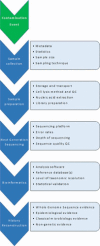Future Technologies
- PMID: 29521257
- PMCID: PMC11633560
- DOI: 10.1128/microbiolspec.EMF-0015-2018
Future Technologies
Abstract
Microbiome analysis of environmental samples may represent the next frontier in environmental microbial forensics. Next-generation sequencing technologies significantly increased the available genetic data that could be used as evidentiary material. It is not clear, however, whether the microbiome can scale across institutions using forensic-based evidence due to the data resource requirements and the associated costs of maintaining these databases. A successful microbiome study is impacted by the quality of the information gathered and the steps in sample processing and data analysis. To ascertain the validity of methods and the results obtained, there needs to be a stringent procedure to validate the methods and ensure that the results are comparable and reproducible, not only within the laboratory but also between laboratories conducting similar research. Of primary importance for meaningful microbiome studies is an experimental design that leads to carefully executed, controlled, and reproducible studies. The microbiome literature contains a fair share of anecdotal descriptions of microbial community composition and "diagnostic" relative abundance of the taxa therein. These studies are now being supplemented by experimental designs that feature repeated measurements, error estimates, correlations of microbiota with covariates, and increasingly sophisticated statistical tests that enhance the robustness of data analysis and study conclusions. It is imperative to be careful, especially when carrying out attribution studies, to be fully aware of the possible biases included in a specific sample being analyzed.
Figures
References
Publication types
MeSH terms
LinkOut - more resources
Full Text Sources
Other Literature Sources


